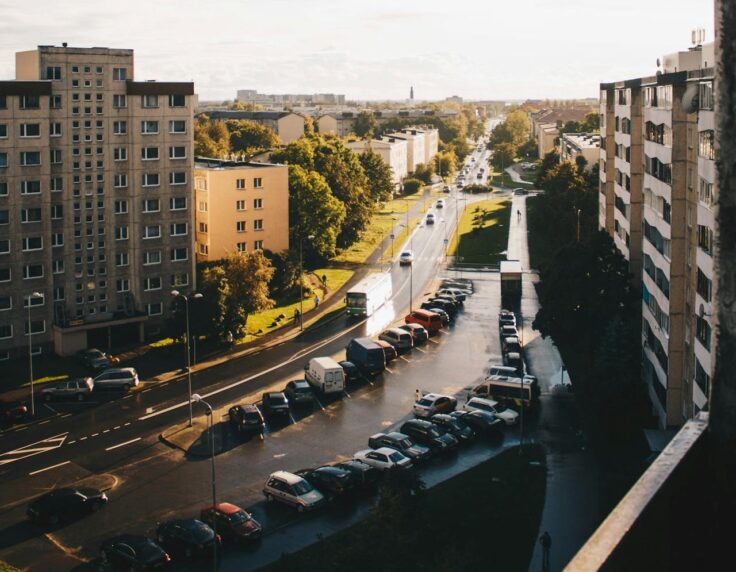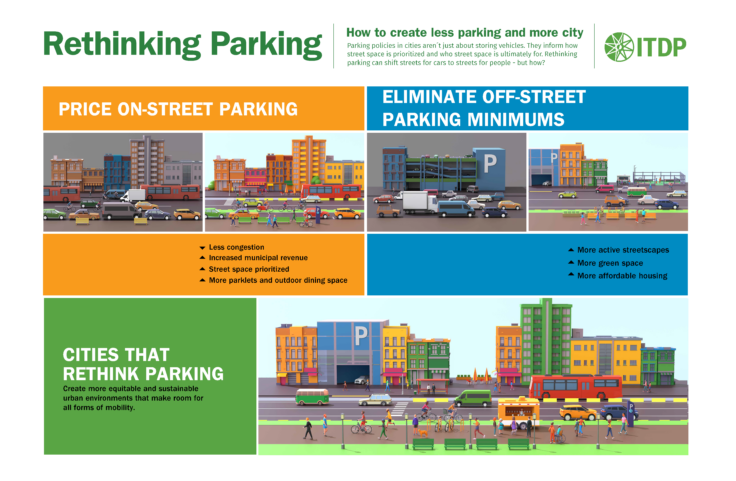September 26, 2024
Too Much Urban Space is Used for Parking. What Can We Do About It?
Conversations about livability in cities often focus on the elements that enable people to access jobs and economic opportunities, social networks, proximity to education or healthcare, and cultural fulfillment.
Download The Opportunity of Reforming Parking and join the From Meters to Mobility webinar.
Such elements include low-carbon, affordable transport options; public spaces that invite connection and socialization; tree-lined streets and opportunities to interact with nature, and so on. Rarely in these conversations, however, do we hear about how private vehicles and parking itself impacts our experience moving around cities. Yet parking especially has a critical effect on the look, experience, and accessibility of every street. Public streets are valuable resources in cities and, now more than ever, many different uses are competing for precious street and curb space: car parking, bicycle and bikeshare parking, taxi and rideshare pick-up and drop-off, cargo loading and unloading, electric vehicle charging, cycle lanes, bus lanes, and much more.
Nevertheless, many cities prioritize on-street vehicle parking over everything else, providing an implicit subsidy for drivers who expect a free or low-cost space to park close to any destination. Similarly, valuable land in downtown areas is often set aside for surface parking or parking garages at the expense of other uses, such as housing, retail, or cultural space. Evidence shows that all this available (but often underused) parking space attracts more driving, and with it, all the negative outcomes that driving generates such as greenhouse gas emissions, harmful pollutants, traffic injuries and deaths, congestion, and beyond. Improving parking management is a tool for a city to limit these negative impacts, deliver better alternatives to driving, and achieve the livable communities their residents deserve. It is important to realize that parking has not always been seen as part of the transport landscape in many cities.
However, in recent years, momentum around parking reform and its linkages to broader transport goals has emerged. Major urban areas like San Francisco, Mexico City, and Vancouver in North America, as well as other cities around the world including Rio de Janeiro, São Paulo, Beijing, and Seoul, have eliminated or reduced parking minimums. This requires a minimum number of off-street spaces for different building uses regardless of local conditions like density or proximity to public transport options. In other cases, like the nation of New Zealand and the US state of California, parking minimums have been removed or lowered at the federal or state level.
At the same time, many cities are recognizing the opportunity of better managing and pricing on-street parking, both to address illegal and unregulated parking that obstruct public spaces and to provide parking that more closely matches real-time demand to free up curb space for other uses. While revenue generation should not be the primary goal of parking management, pricing on-street parking also presents a revenue stream that can support program administration and, in some cases, subsidize other transport projects. For example, on-street parking revenues in the city of Fortaleza, Brazil support the city’s bikeshare program and cycle infrastructure implementation.
To ensure that parking supply and demand are appropriately balanced, cities must understand parking as a holistic ecosystem, with on- and off-street parking ultimately affecting one another.

In ITDP’s new report, The Opportunity of Reforming Parking, the authors underscore the need to address on- and off-street parking together using five city case studies: Zurich, Switzerland; San Francisco, USA; Mexico City, Mexico; Montreal, Canada; and Kigali, Rwanda. The report reinforces the need to re-evaluate the idea that streets should provide space for vehicle storage, thus opening up a world of possibilities for what that space can be and who can benefit from it. Takeaways from these case studies yield four action items that cities need to consider when embarking on parking reform:
- Establish a coordinated vision for parking. Cities should link parking directly to broader mobility and access goals, and it should be part of a coordinated vision for managing and prioritizing public space. This means that parking should be accessible for those who need it, however, given its negative impacts, drivers should be charged to use it.
- Manage on and off-street parking together. Cities should coordinate on- and off-street parking management as part of urban transport planning and management. If only one type of parking is managed while the other remains uncontrolled or underpriced, demand will simply shift towards the cheaper, less-restricted option. Similarly, if parking management is disconnected from city and transportation planning, parking policies may not align with (or even hinder) other transport planning and management efforts.
- Understand your parking picture through data. Cities must understand where on- and off-street parking spaces are and how they are being used. This is critical to inform evidence-based policies such as pricing on-street parking or removing or reducing off-street parking minimums near transit stations. Cities are using a range of technologies and data collection approaches that fit different budgets and technical capabilities to better discern their parking picture.
- Carefully structure funding and revenue flows for parking. A key strength of priced parking programs is that they can generate revenue that offsets program administrative costs and even supports other transport projects. Integrating parking into broader transportation planning and decision making can help to reduce any over-reliance on parking revenues that can make it challenging to remove revenue-generating spaces.
Reviewing outdated parking codes, or developing a new approach to parking where one did not exist before, is a key opportunity for cities to become more livable and attractive places for all people.

